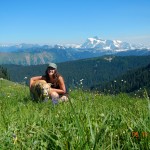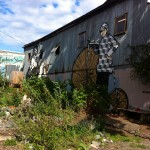Dayaalu Center Celebrates Yoga with Sound
November 20th, 2014
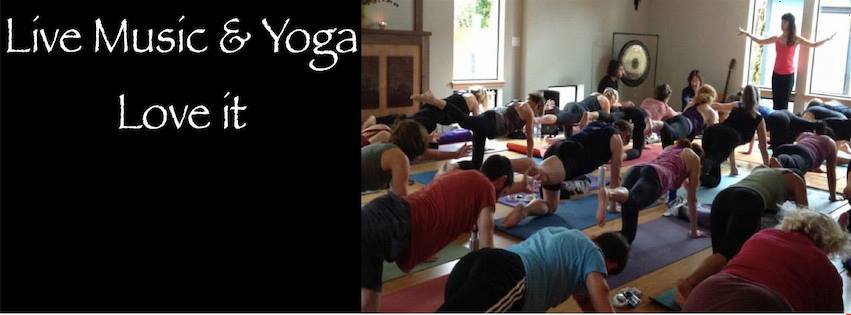
There is a new Sound Flow on Bainbridge Island, and it’s not the whispering breeze flowing in from across the deep blue waters surrounding our home. Dayaalu Center, the island’s year-old healing center with a focus on yoga, massage, acupuncture, Ayurveda, reiki, and other medical practices such as physical and occupational therapy, has made an imprint on the community’s Saturday morning routine by offering Sound Flow Yoga, hosted by yoga instructor Jeny Rae and local musician Jon Crane.
Join members of the island community at nine o’clock in the morning in the warm embrace of Dayaalu’s beautiful property nestled on Wyatt Way NE. Dayaalu, meaning “compassion” in Sanskrit, is one of many emotions conjured upon walking through the beautiful wood-framed entryway into the open bodywork center with incredible wood floors, serene colors, and a tranquil energy. While Jeny Rae guides your body through a kundalini flow, Jon Crane will guide the rhythm through the use of drums, singing bowls, and gong. “When your heartbeat matches to the beat of a drum, that synchronization pulls you toward a deeper connection with all that is,” Rae describes.
While the wide variety of yoga classes offered by this and many other yoga centers may seem overwhelming to begin with, Dayaalu center strives to create a welcoming environment by highly capable teachers with a passion for empowering you to know and love your body and mind. Dayaalu’s commitment to the island community is apparent through their offerings of concerts, dance, seasonal celebrations, and retreats — truly a gem of interconnectedness to each other, our bodies, and the natural and spiritual world around us. If intuitive healing and bodywork speak to you, explore Dayaalu’s vini-theraputic, Tai Chi, integral, or restorative yoga practices; to bring greater intensity to your exercise, experience Dayaalu’s yoga & core and Hatha flow.
After fulfilling the mind-body-soul connection, follow the alluring scents of hot soup and fresh treats around the corner to Dayaalu’s Sukhi Kitchen, a quaint café that offers locally sourced, vegan and gluten-free dishes cooked in the small space just over the counter. Ranging from soups, salads, snacks, and treats, arrive during lunchtime on weekdays to enjoy Sukhi’s hot dishes, or use Dayaalu’s easy payment system to purchase pre-made, health-centered meals from the refrigerator during the center’s business hours. This is a wonderful alternative for those of us working in the Winslow area. And, if you are in the area and need to center and ground yourself during your lunch break, the center offers free lunchtime meditation—because they are here for you.
Dayaalu’s one year anniversary party is this Saturday, November 22nd at 7PM
BIMM Finale, Part 7 – The Bainbridge to Bellingham Pipeline
September 25th, 2014
- Christine & her pal
A garden flourishes in the spring and summer, bursting with color and bountiful harvests. Slowly, each of these lively plants will begin to wilt, dropping leaves and sinking closer to the ground. Eventually, the garden will decompose and freeze through the duration of winter. It isn’t until spring draws near that we must ponder the garden once again, accounting for the perennials that will awaken at the thawing of Earth to relive their dependable and vibrant cycle. The annuals are but a memory, their passionate bursts of life having ended at the first frost, and we must rethink and redistribute these varieties in different parts of the garden—places they’ve never been, where the soil is richer and the sun shines bright.
Since childhood, I’ve lived my life as an annual among perennials, giving every ounce of my spirit and energy and love to each steadfast community that welcomes me with open and productive arms. While the community and landscape of Bainbridge Island is and will remain nourishing enough to bring me back to life over and over again, I must move on and plant my delicate roots in the rich soil of Bellingham Bay. My life on Bainbridge Island altered my future forevermore—as would any life after living in such an empowering and mesmerizing environment. I was so inspired by the idea of regenerating the wealth of knowledge and inspiration I received from various sources on the island—YES! Magazine, our local farming programs, the community and music revolving around Pegasus Coffee House, and YOU—that I applied for and was accepted into Woodring College of Education’s Master in Teaching program at Western Washington University in Bellingham.
The bittersweet transition came quickly, and as eager as I was to get to the new community and environment I now call home, I knew that leaving came at the cost of becoming unfrozen in the timeless sphere beneath which all of us live blissfully on the island. I thought it was gone forever, the equity and togetherness and solidarity and passion and art and Earthly wonders, and prepared myself for withdrawal. But, then I arrived in Whatcom County, where the sun sets the sky ablaze and illuminates the art-covered buildings, garden-covered yards, bike-covered streets, and forest-covered valley between the Salish Sea and the North Cascade range. Here, the community is as vibrant and innovative as the island’s—in fact, the community is quite shared. The Bainbridge to Bellingham pipeline is real, as the exodus of young adventurers brings their journey to the trails and sidewalks of my new beloved streets, where we share music, friendships, art, and a passion for social justice and sustainability.
The Bellingham community is a macro version of our tight island family, made even more vibrant by the transient annuals amongst the homesteading perennial that come together to create a wild and productive multipurpose garden. Here, doors and minds are open, and the last days of sunlight pour inside of both as the mass migration of students inspires an even more bustling community, with events and music and food and beer—endless beer from tens of breweries around every corner—that nourish this hardy garden in the wake of winter. As I write my final words of farewell to you, island community, I smile at the thought of knowing you here, in various forms and faces, and look forward to connecting our communities in the future. Until next time.
–Christine St. Pierre
BIMM Part 6 – The Growing Trend
June 30th, 2014
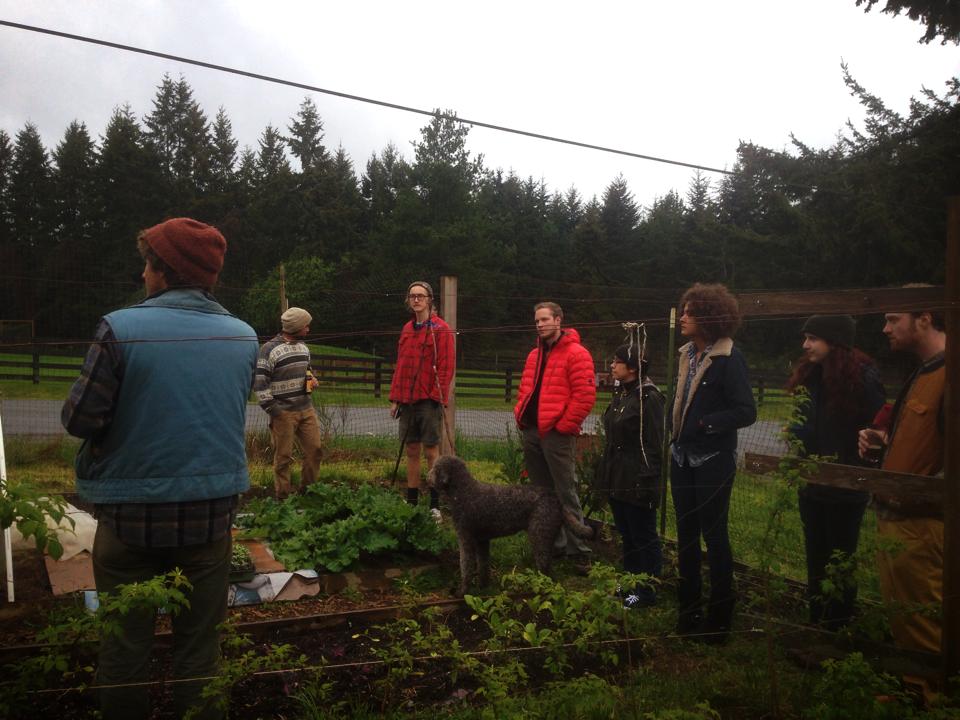
In an era shadowed by threats of environmental catastrophe, economic crisis, and social collapse, we are witnessing a mental shift in the next generation to whom the torch will be passed. By and large, the Millennials, born between 1980 and the new millennium, have been raised in a heavily consumer-centric society that has disassociated with the notion of living simply and sustainably off the land. As society wades deeper into these treacherous seas, communities have taken precautionary steps to keep themselves afloat.
Millennials are rising to the challenge by transitioning into a way of living that reclaims traditions long ago abandoned at the risk of being lost forever, traditions like homesteading, permaculture, fiber and textile production, natural medicine, and sustainable agriculture. As the price of produce and meat increases, so does the shift toward community gardening, urban farming, and agricultural education. Call it nostalgia for a romantically rustic way of life or call it necessity; either way, the growing trend in our generation, and in general, is growing organic food.
On this island, there is no shortage of small-scale farms with a focus on organic food that is grown in healthy rotation with the seasons. These farms, which foster deep community roots and innovative approaches to energy efficiency, such as natural irrigation and solar power, are staffed by pockets of Millennials with a passion for connecting to the earth and growing organic food that nourishes their bodies and the environment.
Nearly all farms on Bainbridge Island are supported by a crew of Millennials driven either by devotion or curiosity, and from what I’ve experienced, they’re really wonderful people—they’re my friends. With lives that can be mapped across the globe, these young farmers make up a colorful portion of this community, contributing music, art, and, well, food, that keep Bainbridge Island moving forward. With long, exhausting days in the sun and an intense summer push, they’re hard to find out on the town, but rather at intimate potlucks and picking sessions around a bonfire surrounded by fields of slow growing produce.
You’ve seen them bouncing between mud-caked work trucks and local restaurants with bins of fresh produce; you’ve smiled at them at the farmer’s market as they explain how to perfectly massage your kale for dinner tonight. They’re rugged and tan, with soil stained fingertips and disheveled hair hidden beneath a wool cap. They travel across the country with all of their belongings packed into their hatchback making stops at farms along the way. They conduct educulture programs aimed at introducing young children to the art of farming organic food and give property tours that showcase their happy plant and livestock production. They’re WWOOFers, interns, grantees, dreamers, spearheads; they are the future of a newfound relationship with food that just might save us all.
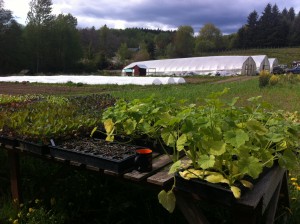
Northwest FolkLife: The People’s Festival
June 4th, 2014

The airport flooded, the highways packed, hotels booked, and sidewalks buzzed with over 250,000 folks from around the world who had arrived in Seattle to enjoy and participate in our annual free festival, Northwest FolkLife. The independent nonprofit organization has held this event in Seattle Center over Memorial Day weekend since 1972, drawing a crowd that consists of diverse cultures and backgrounds for four jam-packed days of music, participatory dancing, cultural showcases, food, and workshops. Local artists shared stages with international names to bring four days of non-stop entertainment; if you were to attend each event to its fullest, it would take 28 days consecutive days to experience!
Gospel, bluegrass, world music, elementary school choirs, local singer/songwriters, funk, country, electronic, Native drum circles, and reggae—the list of music genres is nearly as long as the list of performers squeezed into the festival. On some stages, world dance performers featured traditional ethnic dance to the live music of their culture, while other stages hosted performers getting the dance started in the heart of the crowd until nearly everyone was on their feet. Sunday’s Mosaic Stage featured a full day of reggae, ending with Seattle’s Clinton Fearon & The Boogie Brown Band, a festival staple for more than 20 years and longtime, long-loved reggae group in Seattle.
At Northwest FolkLife, diverse music isn’t the only thing flooding your senses. The smell of funnel cake and ethnic food lingers in the air, swirling with the cool mist from the international fountain beneath the shade of the Space Needle. Children with vibrant face paint zigzagged through the crowds, cotton candy in hand. Some folks rested in the shade, watching collections of hula-hoopers and fearless dancers move to the sounds of the music from onstage. Others enjoyed each others company in the beer gardens featuring organic and gluten free options.
Vendors line the walkways with unique booths and colorful crafts reminiscent of a bohemian street fair. I watched woodworkers, jewelers, batik artists, and clothing designers charm envious customers as I strolled through, savoring the vegetarian sambusa I ordered for lunch from Portland’s Horn of Africa, which serves traditional food from the coast of Northeast Africa. As I wandered into the Fisher Pavilion, lured by the sound of strumming fiddles and tapping feet, to my surprise I caught sight of hundreds of smiling faces dancing in synch. This contra extravaganza draws many generations of contra dancers year after year to experience the folk tradition of contra dancing with a diverse crowd. Beginners are urged to dance with a drastic wave of the arm by red-faced, panting elders who are willing and eager to teach starry-eyed onlookers the ways of contra. I wasn’t brave enough to try, but I felt the energy from the sidelines and smiled along with everyone.
The greatest thing about this festival? It’s free to anyone, even if you haven’t a penny to spare. You’ll find buskers, travelers, and aspiring musicians putting it all on the line between stages, food carts, and craft stands with an instrument or two, an upside down hat with a sign that says “anything helps,” and a passion for music shared by all in attendance. In the crowds, you’ll find local legends, students, neighbors, homeless, out-of-towners, sailors, young families, artists, pockets of pre-teens, and every other walk of life. Judgment is laid to rest at the entrance, and everyone enters on the same level. It’s a wonderfully inclusive festival fueled by the donations of the able and the energy of the willing. Staffed by over 6,000 volunteer performers and 800 volunteers (yes, performers all volunteer!), this is truly a celebration of Northwest culture and togetherness.
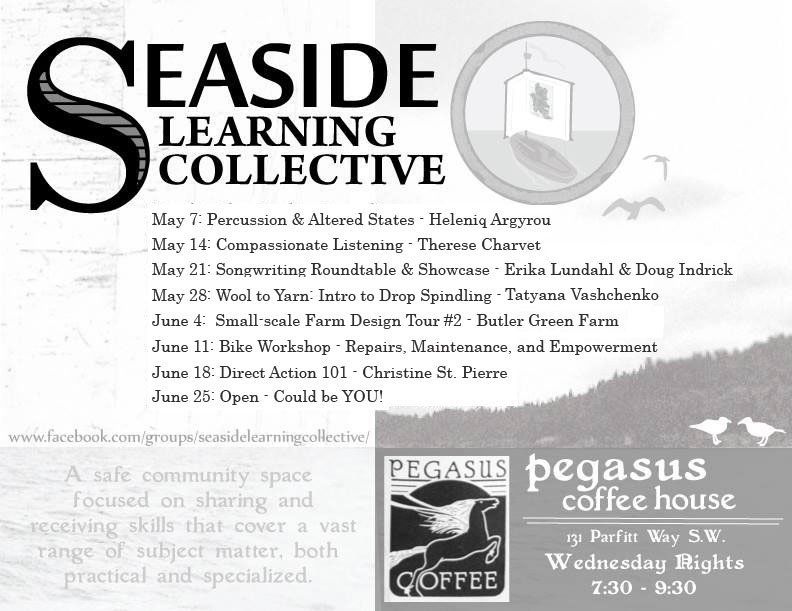
Bainbridge Island is populated by a wide variety of talented individuals, many of whom are deeply rooted in their community. Some are masters in craft trades, others in farming, arts, business, engineering—the list goes on. Each have developed expert skills, and each has the ability to share their skills within the community.
So, when offered Pegasus Coffee House for a location to organize a weekly event, I thought intensely about the direction I wanted to take it. The purpose was to unite the scattered collections of younger, like-minded people who were either brought here to pursue a passion or raised in the area and stayed because of a love for this magical place. Although drinking, games, and music are exciting ways to gather and create friendships, I wanted these events to amount to more than social hour. That’s why, with a little help from my friends, I created Seaside Learning Collective, a free school on Bainbridge Island.
At Seaside, your peers and friends are the teachers, giving lectures, leading discussions or workshops, and sharing their knowledge in order to promote community involvement. These classes demystify topics like homesteading, fermenting foods, or bicycle maintenance. By making these topics accessible, members of the community are more likely to participate at home, which can lower one’s living expenses, strengthen community bonds, and work toward a more sustainable environment and local economy.
The structure of free schools varies across the globe. Initially, fellow organizers and I drafted an intricate outline regarding donations, scheduling, and sign-ups. We researched global free schools to see how they ran. We planned websites with open discussion forums. We invented a money and sign-up system that would provide funds to the class teacher, the free school, and Pegasus. Just before launching, though, we scratched it all and trimmed it down to bare bones: a donation bag is passed around at the end of each class, and each class is open to any and all community members, regardless of advanced sign-up. Free coffee and tea are served during the class, and on special occasions the bar is open and alcohol may be purchased. At its heart, Seaside Learning Collective strives to bring people together for the purpose of advancing knowledge and promoting community.

Ryan Montella taking questions at Morales Farm
The months of March and April held some incredible classes hosted by young members of the community with a passion for their craft. Farmers from Butler Green Farm led a tour through Morales Farm, discussing design strategy and agriculture strategy. Another islander directed a hands-on fermentation and cultivation workshop with various work stations where attendants could make their own kombucha, yogurt, or kraut, and they brought the final products home! On the other end of the spectrum, we have hosted classes grounded in arts and intellect, such as a creative writing workshop or discussion on the importance of gratitude and giving.
The months of May and June are packed with exciting opportunities to participate in a folk songwriting roundtable, learn the basics of direct action and community organizing, experience another farm tour, create your own drop spindle and yarn, or even experience the ancient method of transcendental meditation through percussive drumming, led by a woman traveling from Greece to lead workshops in the greater Seattle area. We are very fortunate to be expanding, both in our teachers and attendants, to a broader audience.
While a class or two has been held at another location on the island for the purpose of a farm tour, most classes occur each Wednesday, from 7:30-9:30 at Pegasus Coffee House. I, along with the rest of Seaside Learning Collective, hope to see you there!
Stitch ‘n Bitch
March 28th, 2014
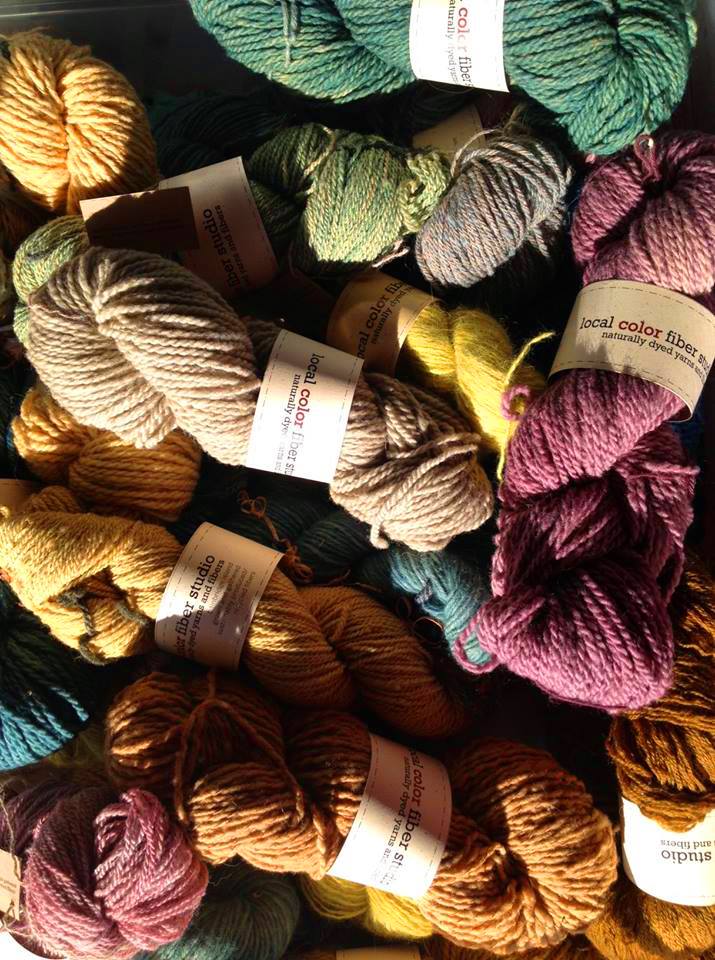
Every Tuesday at Bainbridge Island Brewing Company, a group of wool-clad islanders sit in a circle around heaping piles of yarn, casting and binding and looping and dropping stitches in the slow, methodical creation of their latest sweater, cowl, fingerless gloves, or beanie. The gathering, called Stitch ‘n Bitch, consists of local folks interested in textiles, knitting, drinking craft ales, or genuine conversation.
Knitting has always seemed out of reach—an unachievable skill. I tried to learn a few times, but constantly dropped a stitch in each row, making tiny little triangles that were ultimately useless. I gave up, and as the years have passed, so have the windows of opportunity to learn this social folk tradition. Ironically, I always imagined the years passing while I knit socks on the front porch, swaying in a rocking chair and watchin’ the crops grow. The time had come!
When I approached the group for the first time, I was met with warm smiles and chairs slid over to make room for me. They continued on with their conversations while their buzzing fingers robotically repeated pattern after pattern, seemingly detached from the rest of their bodies. Impressed and intimidated by their dexterous mobility, I introduced myself as an aspiring knitter with an unfortunate “ya can’t teach an old dog new tricks” disposition. The group deflected my lack of confidence, having all been there at one point, and offered words of encouragement, assuring that I would be able to knit and create in no time. Then, one stitcher pulled a beautiful ball of steel blue merino wool from her bag and held it out to me.
“Here, learn with this!” she suggested.
“For me? You’re just giving this to me?” I asked, shocked.
“Do you like it?”
“Yes, it’s amazing!”
“Then make something beautiful with it!” She smiled, and everyone continued on chatting.
No big deal. Just a perfect ball of merino wool yarn. Gifted to a stranger, no less. What a community we’ve got here on the island! The next day I bought my first pair of knitting needles–sized nine per suggestion of the group–and began courting a lifelong relationship with knitting. Since that first Stitch ‘n Bitch, I haven’t come far with the craft, but I have built relationships within the group. Each stitcher has a loving, warm character. Often they’ll cook each other food and bring a sharing dish to the gatherings.
The gatherings are organized by Tatyana Vashchenko, co-founder of Local Color Fiber Studio, a fiber dying duo consisting of Tatyana and Emily Tzeng, who cultivate and forage various plants to use for dying natural yarns. These two sell their organically pigmented yarns at farmers markets and online at localcolorfiberstudio.com. Come meet Tatyana, Emily, and the rest of the Stitch ‘n Bitch craftspeople on Tuesday nights between 7 and 9 PM at Bainbridge Island Brewing Company. Support your community, support local art, and, while you’re at it, support local beer!
Bainbridge Millennials Mystery – Part 4 – The Writing Life
March 13th, 2014
For all of you with pretentious-detectors, beware: I have welcomed the identity of poet into my life. Before, I just considered myself someone who wrote occasionally. Now I think that poetry, the art of poetry, is a way that I understand the world around me. How do I explain? Take for example photography. Once you get more and more involved in photography, you are not only a photographer for the split second you snap a photo. No, you walk around, always, seeing things in terms of composition, of lighting, of placement and movement. It is by continuously remaining open that you can then relate your experience in a moment of creation. So it is with poetry, I think. You walk around wide-eyed and in love with each thing you see then write about it.
The bizarro videogame Katamari Damacy comes to mind too. The sole purpose of the game is to roll around as a sticky ball and grow bigger. You start out sticking to small objects and increasingly gather larger and larger items on your body until soon you are rolling down skyscrapers. I think that it works as a metaphor for the artistic endeavor. From the second I leave my front door and head out into the world for the day, I am a sticky glob and take note of everything I see. By the end of the day I am chock full of the ephemera of my day. To write a poem I would take each piece off of me and lay it on the page. If I do a good job, the poem should stand as a simulacrum of the concert of emotions of my day. If I do a really good job, I manage to pick off all the junk of my day and get down to my skin and, once there, pick off the flesh with renewed vigor.
Serendipitously enough there is a copy of Annie Dillard’s The Writing Life in the bookshelf in the house where I live. Ever since reading Pilgrim at Tinker Creek I have been desperately in love with Dillard. She too lived on an island in the Sound, though more isolated and further north than I am now. The Northwest, it seems, is a literary hotspot. The rain, the mountains, the forest, the countless coffee shops, all of it gestures toward the literary. So I decided to pick up her book I hadn’t (gasp) yet read. In it, she remarks upon the difficulties and impossibilities of leading a writer’s life. She tells a story of trying to chop firewood: for the longest time she was terrible at it, could never make sizable pieces of firewood for burning, only small useless chips. Eventually she learned that to do it right, you don’t aim for the wood but the chopping block beyond it. After that realization she had a high stack of wood ready to burn, hurrah hurrah! And so it is with writing, you aim, always, for the obstinately blank page, the screen of flaring pixels, and try to etch out your flawed creation despite the sea of blankness and incorrigibility.
From what I can see so far, Bainbridge is a fantastic place to be an artist. Open mics are everywhere, the art museum is free, people are warm and welcoming and willing to share their craft. Guitar players come out in droves to perform, you can’t walk down the street without bumping into a writer, and artist exhibitions pop up continuously. So it is not so hard to be young on such an island. It is quite easy to walk around and feel welcome and on the cusp of many chance encounters. And so I throw my own voice out there, in the form of a small poem, to join the artistic community of Bainbridge. The Pacific Northwest has me thinking about the incomprehensibility of city sewer systems, mountains, whales, the Pacific Ocean, and ant colonies.
Lesson from Blue
Dates, appointments, schedules,
details, all details, slide right
off me like sea trash off a lost whale
during a cataclysmic storm in the far reaches
of the Bering Sea in the icy grips of November.
That is ok because even though I cannot hold
a pen between my flippers to write you,
I am a whale and can sing-song a semblance
of a message for the whole ocean to hear:
I am late, but coming.
Bainbridge Millennials Mystery – Part 3
March 13th, 2014
By Andy Butter – The lovely Christine St. Pierre (See BIMM Part 1 & 2) and I share a house, internships at YES! Magazine, and barista duties at Pegasus Coffee House. We’ve also been jointly asked to blog about our experience of being “young on Bainbridge”. I think that this will be great for you, the reader, to see how two people put in the same place can come out with two vastly different (or not?) experiences. But first, a little background info from me.
I moved to Bainbridge at the beginning of the new year to start a four-month long internship at YES! Magazine. After a grueling 40-hour Amtrak ride all the way from Minneapolis, which promptly dispelled any romantic notions I had of train travel, I found myself, still swathed in all my winter gear, in downtown Seattle. Laden with all my belongings, I waddled to the ferry and bought my first of many tickets to come.
Trains, busses, ferries, skyscrapers, taxis, business-people. All of it strange and unfamiliar to me. I grew up in Grand Marais, Minnesota, a tiny town of 1,300 people on the northern shore of Lake Superior. Grand Marais has one stoplight, two grocery stores, and three seasons: almost winter, winter, and still winter. To me, Bainbridge is not small or remote but quite a bustling place, especially considering its proximity to Seattle. Living on Bainbridge is not a tuning-down, a sinking into a bucolic dream, but instead a foray into a chaotic whirlpool of new faces and places. I can’t stand and gawk forever though, I have to get out in the world and see it, then blog about it!
An important part of integrating yourself into a new place is to meet people and make friends (duh). Sometimes that’s easier said than done. But no worries, for those less gregarious, less adept at navigating the innumerable pitfalls of social interaction, I have compiled a bullet-proof list of my way to make friends while slinging coffee at Pegasus. Godspeed ye, and good luck making friends out there, friend.
Midwestern Themed Clothing
I have a sweater that features two proud owls and the word “Wisconsin” in bold white type. I have a bright blue shirt that has the outline of the Upper Peninsula of Michigan encased in a heart. I often wear shirts that feature Northland College, my alma mater in Wisconsin. Every time I don cloth from the heartland I am always engaged in a fun conversation while I’m cashiering. Apparently, everyone on the West Coast lived in the Midwest at one point, or has a half-step-semi-second-cousin-in-law that does. Once I admit my origins the conversation turns to the weather. Once we start talking about the weather I am in the zone; I grew up in Minnesota, I could talk about the weather for days. Friendship: forthcoming.
Self-Deprecative Humor
Did you hear about the giant that threw up? Really? Because it’s all over town. How do you organize a party for the solar system? Simple, you just planet. These jokes are terrible, I’ll agree, but if you happen to chuckle, or at least show the common courtesy of chortling, then we have a starting point for rapport. After rapport, a budding acquiantanceship. Soon I’ll be your children’s godfather, just you wait.
Swag
Only to be used ironically. Results may vary.
A Sprinkling of Pop Culture References
After I take someone’s order and they fumble around for exact change I may ask them “Where’s the money Lebowski?” If they raise an eyebrow and give me the $2.17 without saying a word, I move along. But if they proudly proclaim their proclivity toward nihilism, then we have a blossoming friendship on the way. Don’t be disheartened if the references don’t start a friendly conversation right away. This method of friend-making often takes time and persistence. It also has the possibility of alienating you from those around you. Play it cool, man. If 90’s movie quotes aren’t working out, try a line from Game of Thrones. No one picking up on your amazing whistled rendition of Europe’s “The Final Countdown”? Bring it back with a hummed chorus of the Beatles’ “Penny Lane.”
Note for those that enjoy higher-brow culture: This method of making friends can work for you too! For example, I saw a young woman reading a book of poems by Elizabeth Bishop. We talked about our favorite poets. We then learned each other’s names and shook hands. Friendship!
BIMM Part 2 – Coffee Haus Connections
February 7th, 2014
By Christine St.Pierre – The hinges squeak on the coffee house door and I shift my gaze toward the entryway with the rest of the Pegasus staff, programmed to greet the sound as another customer shuffles in from the cold. From behind the counter, I greet the newcomer with a smile and ask, sincerely, “How are you?” Too often, the person is shocked by the authenticity in my tone; they’ll raise their brow, tilt their heads, pause to think, and, with a sigh, say something to the effect of, “I’m well, but [insert personal detail here].” Step one in making a new friend: care.
Step two: remember. The next time they walk in through those squeaky front doors, I’ll ask, “How did it go with [restate personal details from last conversation here]?” And so it begins; a relationship that had the dreary potential of being a simple exchange of money and coffee becomes something more. This is how I met most of the folks on the island with whom I’m building strong friendships—young or old, male or female. I realized that this little community wants to let you in, so I found an opening and slipped on through.
The final step: memorize their drink orders. Do this and you’re in forever. No foam. Soft-boiled eggs. Add an inch of water. Tie the tea bag. Whole wheat, a little burned. Split-shot quad-shot extra dry soy cappuccino with a splash of vanilla and sugar in the raw. Extra hot, please!
Working these shifts is the equivalent of hanging out with friends in my kitchen. Regulars get their drinks and sit at the bar. We begin chatting, and more of them file in, greeting each other and catching up. They leave together in small groups, probably off to a job or farm or hike or musical endeavor, and I feel all warm inside knowing I’ll see them the next morning—same place, same time, same drink.
Since this friendship journey began, I’ve been to some really cool places with some really cool people. The Grand Forest, for example, has a beautiful field at the end of a series of trails that is perfect for cloud gazing, singing songs, and sunset yoga. Once, on my way to this field, I ran into a Pegasus friend who was heading into the forest to gather stinging nettle with a group of plant-loving locals. Later, we crossed paths again, and they graciously shared stinging nettle pesto and soup with me. As the clouds parted, we stood in a circle and dined on the foraged nutrition, photosynthesizing while we discussed our appreciation of the forest.
Of course, there are less happenstance ways to form bonds and experience the island, like attending the open mic (Tuesday) or open jam (Thursday) nights at Pegasus. If, like me, you’re not a trained musician, bring your poetry on Tuesdays and slam it out! Or, if, like me, you love to sing, bring your voice on Thursdays; Larry, a regular jammer and real sweetheart, has an extensive catalogue of folk, blues, and bluegrass songs that are easy to learn, and he would love to add to the queue if you’ve got something in mind. The Bainbridge Brewery also offers live music on Wednesday evenings, which makes for a wonderful transition from climbing at the Island Rock Gym just across the Coppertops parking lot.
Not long ago, I began my life on the island attending events like these by myself, enjoying the culture while watching the community interact from a distance. Now, I’m in it, and all it took was a little coffee.
By Christine St.Pierre – Downtown Seattle seemed to vibrate, its lights pulsating with electricity. Standing on the balcony, I watched the city grow dim and disappear as the ferry slipped into the thick fog surrounding Bainbridge Island. Moonlight illuminated the small landmass before me, its ridge jagged from the treetops of giant evergreens. Small houses dotted the shoreline with kayaks and beach chairs along the water’s edge. The ferry’s engines turned off, and we coasted into the harbor.
Slowly, I inhaled through my nose; the smell of seawater, kelp, and dense forest flooded my senses. A calm overcame me. Leaving the sleepless bustle of Seattle behind, the island immediately offered a tranquil escape. The moonlight lit my path as I walked to my new home from the ferry station. Sleepy, eclectic storefronts boasted of a lively community, and I was eager to discover what the sunlight would bring the next morning.
I awoke in a beautiful cabin home with a wall of windows that overlooked a yard decorated with large ferns and old growth trees. The other interns living in the house slowly filed into the kitchen to boil water for their morning tea, and we elaborated on what drew us to the island for an internship at YES! Magazine. Writers, activists, and lovers of the outdoors, each of us was eager to plant roots in the island’s various organic farming, music, art, and writing circles. So began the fun part: finding them.
Our home in the southeastern corner of the island is a short bike ride away from downtown Winslow, the community hub that welcomes the flow of ferry passengers as they disembark from the terminal. All day, people wander in and out of the assortment of local businesses that line the streets, greeting each other by first name. The general aesthetic and attitude is that of humility, genuine happiness, and an appreciation for their shared island home. Even the sun seems to shine more often here.
I had heard rumors of the island being a desert of twenty and thirty-something folks, but immediately I caught glimpses of them everywhere, grabbing lunch at the Town & Country grocer, sipping coffee, or driving trucks filled with crates of locally grown produce along Winslow streets. They exist amongst the families and tourists, a rare species that can be seen anywhere at any time. The tricky part is actually getting to know someone. From there, it’s a domino effect. I landed a job at Pegasus Coffee House, which filtered me directly into a scene composed of sailors, famers, artists, writers, musicians, yogis, locals, transplants, and everything in between. Quickly, I became acquainted with a handful of locals and began my transition into island life.
My adventure to Bainbridge Island originated as a career opportunity, one that would come and go, offering professional skills and connections that would lead me into a future in editing. Upon arriving, though, I sensed that I would weave myself into the conscious community before me—one that I had unsuccessfully searched for in Seattle—and remain for much longer than planned.
I was right. Over time, this island would become my home.

